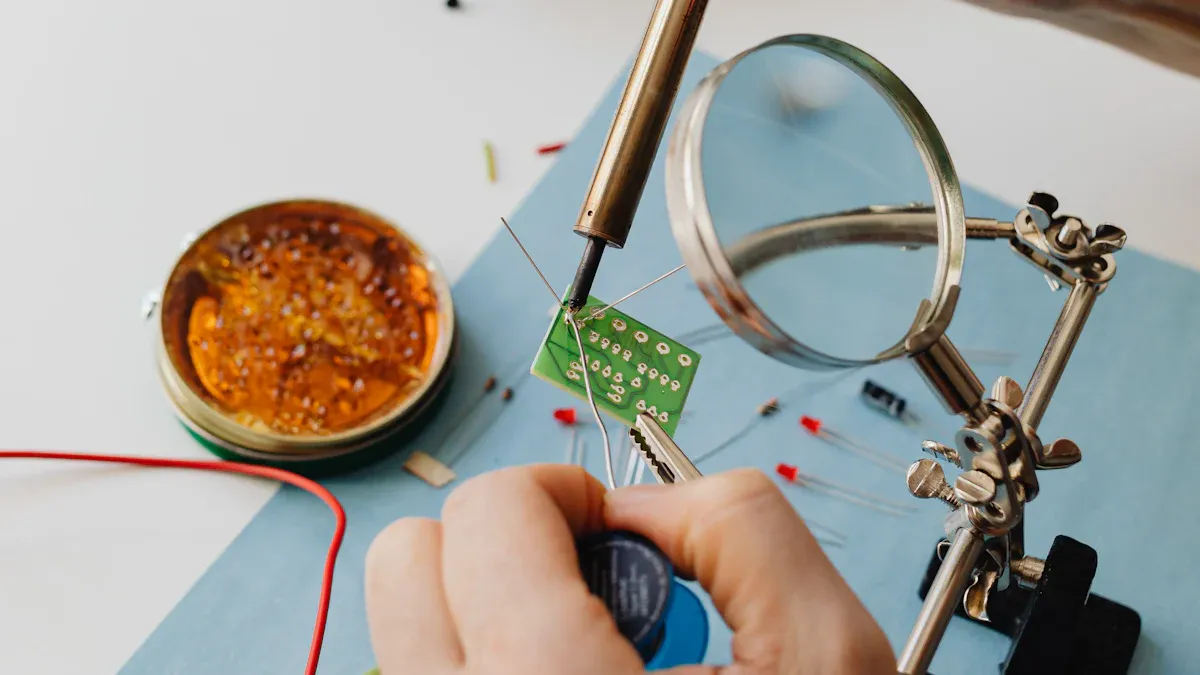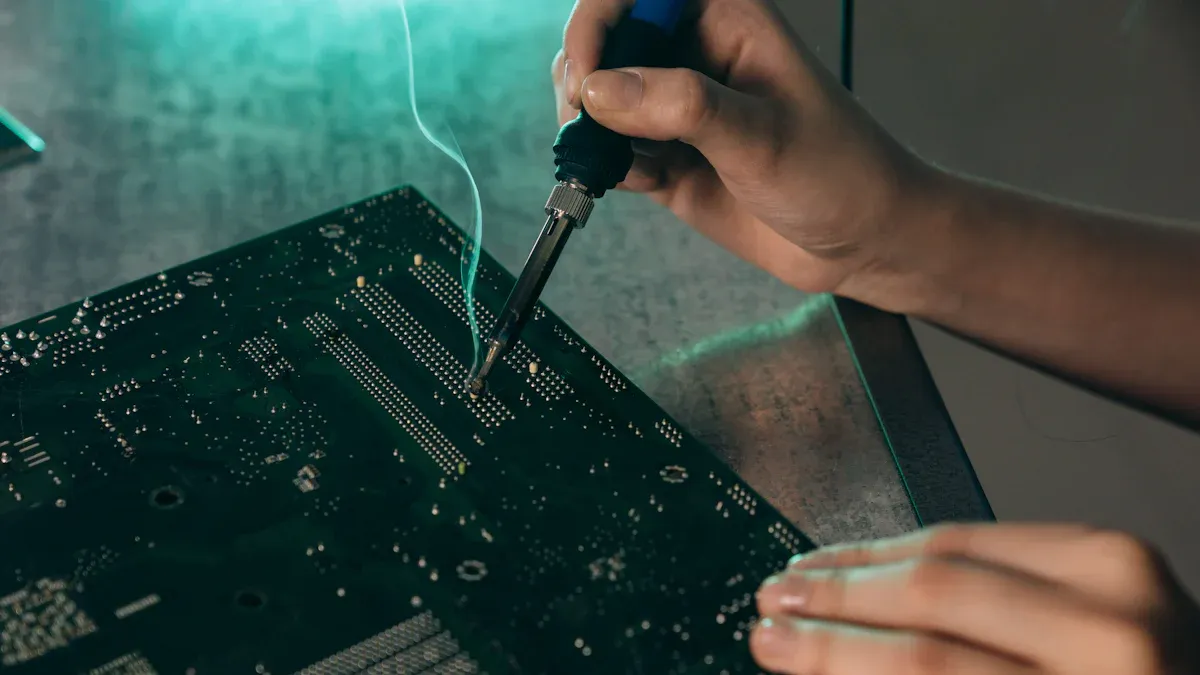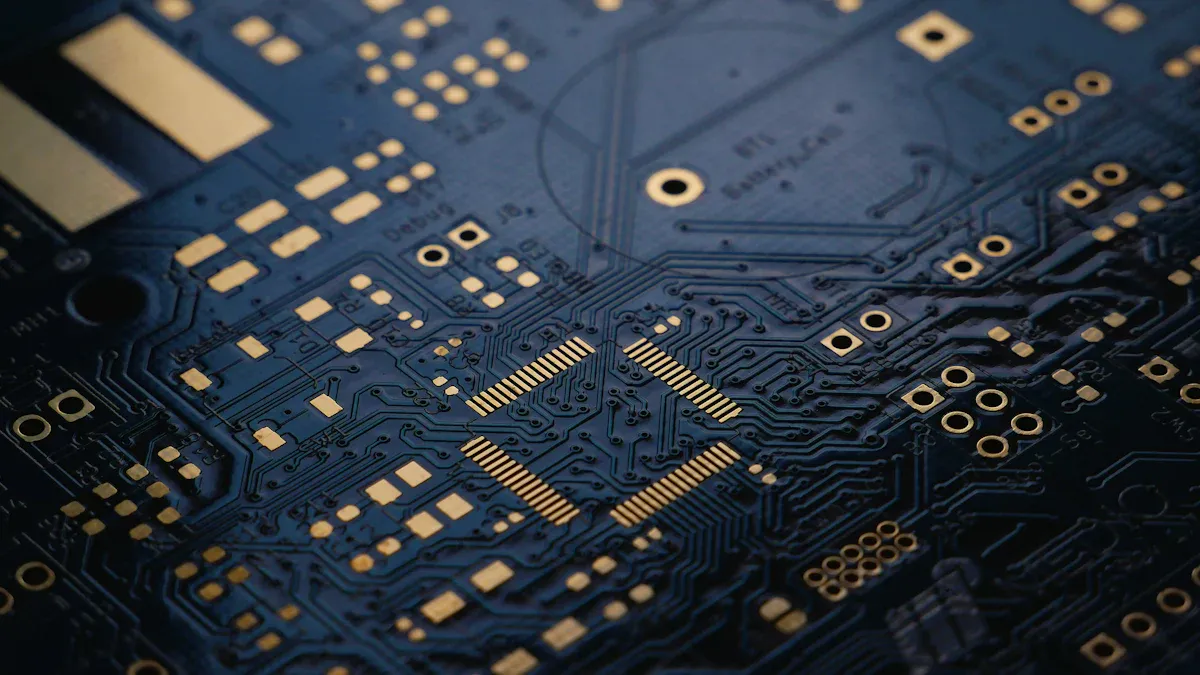How Reflow Soldering Temperature Zones Impact PCB Quality

Reflow soldering needs careful control of four heat zones. These zones help make strong and good-quality PCB connections. Each zone has a special job in the process. Keeping the right temperature is very important. For example:
Leaded solder has a heat range of about 30°C, lowering mistakes.
Lead-free solder, like Sn/Ag/Cu, has a smaller range of 18°C.
Workers often stay within an 8°C range to avoid problems.
This accuracy is key in surface mount technology. Even small heat changes can cause bad soldering.
Key Takeaways
Adjust the four heat zones in reflow soldering for strong PCB connections.
Pick the right temperature settings for your PCB design to stop issues like parts lifting or solder touching where it shouldn't.
Check your reflow oven often to avoid overheating or uneven heat, which can harm parts.
Heat and cool slowly to prevent stress and make solder joints stronger.
Test solder joints in different ways to make sure they last and work well.
The Four Temperature Zones in Reflow Soldering

Preheat Zone: Slowly Raising Temperature to Avoid Damage
The preheat zone is the first step in reflow soldering. Here, the heat rises slowly to get the PCB ready. A gradual increase in temperature stops thermal shock, which can harm the board or parts.
It keeps soldered parts from cracking due to uneven heat.
A steady rise in heat protects the board and its components.
This step is very important for PCB quality. By controlling the heat carefully, the board stays safe and strong during the process.
Soak Zone: Balancing Heat and Activating Flux
In the soak zone, the heat evens out to prepare the solder paste. This step spreads heat evenly across the PCB. It also activates flux in the solder paste, which cleans metal surfaces by removing oxides.
The soak zone is key for even heating. Without it, some spots might stay cooler, causing bad soldering. Keeping the heat steady here helps the solder stick properly.
Reflow Zone: Melting Solder for Strong Connections
The reflow zone is where the solder paste melts and connects parts. The heat here reaches its highest point, about 15 to 25°C above the solder’s melting temperature. This makes the solder flow and stick well to the PCB and parts.
Getting the right peak heat is very important. If it’s too low, the solder won’t melt fully, making weak joints. Too much heat can harm the parts. Careful control here ensures strong and lasting solder connections.
Cooling Zone: Hardening Solder for Strong Connections
The cooling zone is the last step in reflow soldering. It helps make sure your PCB is strong and reliable. In this stage, the heat slowly drops. This lets the melted solder harden and form strong links between parts and the PCB.
This step is key for good solder joints. As the solder cools, it creates a strong bond between the parts and PCB pads. If cooling happens too fast, cracks or weak spots can form. If cooling is too slow, the solder may not harden properly, making weak joints.
The cooling zone's heat pattern should match the reflow zone but in reverse. Slowly lowering the heat stops damage to sensitive parts. Careful cooling makes sure the solder joints stay strong and handle stress during use.
To do this well, watch the cooling speed. Make sure it matches the solder paste's needs. Steady cooling makes better bonds and fewer problems. This step is very important for making high-quality PCBs that work well in different uses.
Impact of Temperature Zones on PCB Quality
Avoiding Common Solder Defects (Voids, Tombstoning, Bridging)
Controlling heat zones in reflow soldering stops common problems. Voids happen when gas or flux gets trapped, leaving gaps. Keeping steady heat, especially in soak and reflow zones, reduces voids. Tombstoning happens when parts lift or tilt from uneven heat. Slow heating in the preheat zone and even heat in the soak zone fix this. Bridging occurs when solder connects wrong pads due to too much paste or overheating. Watching reflow zone heat ensures solder melts evenly and stays in place.
A study shows how heat control prevents damage. For example:
What Happens | |
|---|---|
550 | No major damage below this temperature. |
640 | Damage starts to appear. |
740 | Big damage with no sample peaks left. |
593 | PCB damage in wet sludge at 0.1 seconds. |
1316 | Extreme PCB damage at 2.5 seconds. |
By keeping heat zones right, you avoid these issues and get better soldering.
Managing Thermal Stress on Components and PCB Materials
Fast heat changes can harm parts and PCB materials. It can cause cracks, bending, or layers peeling apart. Slow heating in the preheat zone and steady cooling in the cooling zone help stop this. Good heat control makes parts last longer and work better.
Thermal checks find hot spots and help place parts better. You can use tools like math, models, or sensors to spot and fix problems. Checking heat during PCB design helps find hot areas early. Fixing them keeps parts safe during soldering and use.
Too much heat can ruin parts, making them work less or fail. By managing heat well, you make parts last longer and work better.
Ensuring Strong and Reliable Solder Joints
Good solder joints need the right heat in all zones. The reflow zone is very important. It melts solder fully to make strong connections. If heat is too low, solder won’t stick well, making weak joints. Too much heat can hurt parts and weaken solder.
Studies show good heat control makes solder joints stronger. Different heat levels cause different stresses, affecting how long joints last. Keeping reflow zone heat steady makes joints handle stress and temperature changes better.
Strong solder joints are key for PCBs to work. Cooling slowly hardens solder and strengthens bonds. Slow cooling stops cracks and keeps joints strong under stress. By watching heat zones, you can make PCBs with solid and reliable solder joints.
Stopping Overheating or Not Enough Heating Problems
Too much or too little heat can harm PCB quality. Controlling the heat in all zones, especially reflow and cooling, is key. Overheating can break parts, and not enough heat makes weak joints. Knowing these risks helps you get better soldering results.
Overheating can ruin parts early. Too much heat damages sensitive parts, making them fail or work poorly. For example, overheating in the reflow zone can burn parts or peel PCB layers. To stop this, watch the peak heat closely. Keep it within the solder paste's safe range. A good reflow oven helps control heat well.
Not enough heat causes cold solder joints. These happen when solder doesn’t fully melt. This makes weak connections and poor sticking. IPC-A-610G standards say cold joints come from low heat. To fix this, make sure solder paste melts in the reflow zone. Even heat and proper heating methods make strong solder joints.
Here’s a simple table showing how heat affects soldering:
Problem | Cause | Fix |
|---|---|---|
Overheating | Too much heat in the reflow zone | Watch peak heat and adjust oven settings. |
Not enough heating | Low heat stops solder from melting | Heat solder paste to its melting point. |
Weak solder joints | Bad cooling or uneven heat | Cool slowly and spread heat evenly. |
Cooling is also very important. Cooling too fast can crack solder joints or make weak spots. Cooling too slow stops solder from hardening right. Follow the solder paste’s cooling needs for the best results. Steady cooling makes strong bonds and fewer problems.
By managing heat in all zones, you avoid overheating and underheating. This improves soldering and makes PCBs last longer and work better.
Factors That Affect How Temperature Zones Work
How Solder Paste Type and Mix Matter
The kind of solder paste changes how heat zones work. Solder paste has metal bits, flux, and other stuff. These parts decide how it reacts to heat. For example, flux cleans metal in the soak zone. Metal bits melt in the reflow zone to make strong joints.
Studies show using the right amount of paste is important. It helps the ball alloy and paste alloy mix well, even at low heat. The right amount keeps the ball alloy in the joint for strong soldering. Too little paste makes weak joints. Too much paste can cause problems like bridging.
How PCB Material and Thickness Affect Heating
The PCB's material and thickness change how it heats up. Thicker boards heat slower, which can delay soldering. Materials like aluminum spread heat fast. Others, like FR4, hold heat longer.
You need to change the heat settings based on the PCB. Thicker boards may need more preheat time for even heating. Without this, uneven heat can cause problems like cold joints or layers peeling apart.
How Component Size and Heat Sensitivity Matter
The size and heat sensitivity of parts also matter. Big parts soak up more heat, leaving smaller parts too hot. This can damage small parts or make weak joints.
Research shows heat shields can protect sensitive parts during rework. A heat shield near the heat source lowers heat on nearby parts. This is helpful for packed boards like BGAs, where heat sensitivity is a big deal. By controlling heat, you can make better joints and keep parts safe.
Why Setting Up and Checking Your Reflow Oven Matters
Setting up and checking your reflow oven is very important. A good setup makes sure each heat zone works right. This lowers mistakes and makes your PCB assembly more reliable.
Modern reflow ovens have many heat zones. These zones let you control heat better. They help spread heat evenly across the PCB. For tricky assemblies, ovens with 8 to 10 zones work best. They stop problems like uneven heat, which can cause solder issues like bridging or tombstoning.
Checking the oven’s heat is also very important. Use a profiler to see how the oven heats up. This tool shows if the set heat matches the real heat. Fixing any differences helps the soldering process meet the right standards.
A good setup also lets you adjust the oven for your PCB’s needs. Thicker boards or parts that don’t like heat need special settings. Without these changes, parts can get damaged or solder joints can be weak.
To keep your oven working well, check and adjust it often. This keeps the heat zones working right over time. Regular checks make soldering better and help your oven last longer.
By setting up and checking your oven, you control heat better. This lowers mistakes and makes strong PCBs that meet industry rules.
Practical Tips for Optimizing Reflow Soldering Temperature Profiles

Picking the Best Temperature Profile for Your PCB
Choosing the right temperature profile is very important. It decides how heat is used during soldering. This affects how strong and reliable the solder joints are. Think about your PCB's design when picking between two profiles: ramp-to-peak or ramp/soak/reflow.
Ramp-to-Peak Profile: Heat rises slowly until it reaches the melting point. This works best for simple PCBs with fewer parts.
Ramp/Soak/Reflow Profile: Heat stays steady in the soak phase before reaching the peak. This is better for complex PCBs with different-sized parts.
Matching the profile to your PCB helps heat spread evenly. It also lowers problems like tombstoning or bridging. Studies show adjusting ramp slope, cooling slope, and peak heat improves soldering. Using these features together makes soldering more consistent.
Tip: Use tools to check your temperature profile. Compare the data with solder paste and part needs to make sure they match.
Keeping an Eye on Reflow Oven Settings
Watching your reflow oven closely helps make good PCBs. Regular checks and fixes stop temperature problems that can hurt soldering quality.
Check the oven often to find delays or uneven heating. For example, one study found an oven was 18 seconds late reaching the right heat. Fixing this made soldering better.
Understand thermal inertia. Changes in oven settings may take 20 seconds to show results. Keep checking to adjust quickly.
Clean and tune your oven often. This stops uneven heating and keeps all zones working well.
Note: Advanced ovens with many zones give better control. But even these need regular checks to stay accurate.
Testing Soldering Results for Reliability
Testing solder joints is key to making strong PCBs. Different tests can check how reliable and durable your soldering is. These tests also show areas to improve.
Testing Method | What It Does |
|---|---|
Tests solder joints under changing temperatures. | |
Exploratory Data Analysis (EDA) | Finds factors that affect solder joint life. |
Linear Mixed Effects (LME) | Models reliability using random factors. |
Artificial Neural Networks (ANN) | Predicts solder joint reliability with high accuracy. |
Multiple Linear Regression (MLR) | Offers simple predictions for solder joint performance. |
Decision Trees (DT) | Shows relationships using a tree-like structure. |
Thermal cycling tests copy real-world conditions by changing temperatures repeatedly. This checks if solder joints can handle stress. Advanced methods like ANN predict reliability well, helping you improve your process.
Tip: Use more than one testing method for better results. This ensures your solder joints meet standards and work well in different situations.
Avoiding Common Mistakes in Temperature Control
Controlling temperature is very important for good soldering. Mistakes can cause defects, broken parts, or weak connections. Knowing common errors and fixing them improves your process.
Overheating Components: Too much heat can harm sensitive parts. This happens if the oven isn’t set right or the heat goes above the solder paste’s limit. Always follow the solder paste’s temperature guide.
Tip: Check your oven often to keep the heat accurate.
Uneven Heating: Uneven heat can lift one side of a part, called tombstoning. This happens from uneven heat sinks or low preheat temperatures. Align parts well and keep preheat settings steady to stop this.
Non-Wetting Solder Joints: Not enough heat or a bad PCB finish can cause solder not to stick. Use a better surface finish and make sure flux works well during the soak zone to fix this.
Inadequate Inspection: Skipping checks can miss problems. Use magnifiers to check solder joints for gaps, cracks, or weak spots.
Practice Makes Perfect: Keep practicing soldering. If a joint looks bad, reheat it to fix it.
Improper Cooling Rates: Cooling too fast can crack solder joints. Cooling too slow can stop solder from hardening. Follow the solder paste’s cooling guide for strong joints.
Setting the right heat profile helps reduce problems and gives better results. Learn about your PCB and oven to avoid heat issues and make high-quality boards.
The four temperature zones in reflow soldering are very important. Each zone helps make strong and reliable PCBs. Good heat control stops mistakes and improves PCB quality.
Key Points About Managing Heat:
Reliability: Right heat settings make PCBs last longer.
Performance: Correct temperatures help devices work in all conditions.
Safety: Avoiding overheating keeps parts and users safe.
With better technology, controlling temperature zones is key for making durable electronics.
FAQ
What does the preheat zone do in reflow soldering?
The preheat zone slowly warms up the PCB. This stops sudden temperature changes that could damage it. It also spreads heat evenly and gets the board ready for the next steps.
Why is flux activation needed in the soak zone?
Flux activation cleans metal surfaces by removing oxides. This helps the solder stick well and avoids problems like weak joints. Skipping this step can make solder connections fail later.
How can you stop parts from overheating during reflow soldering?
Check the oven's peak temperature settings often. Make sure they match the solder paste's heat limits. Use tools to monitor and adjust the oven for accurate heat control.
What happens if cooling is too fast or too slow?
Fast cooling can crack solder joints or make them weak. Slow cooling might stop the solder from hardening properly. Follow the solder paste's cooling guide for strong connections.
How do you pick the best temperature profile for your PCB?
Think about your PCB's design, part sizes, and solder paste type. Use a ramp-to-peak profile for simple boards. For complex boards, use a ramp/soak/reflow profile. Match the profile to your PCB for the best results.
Tip: Test your temperature profile with thermal profiling tools and adjust as needed.
See Also
Boosting Project Efficiency With Rapid PCB Assembly Prototypes
A Comprehensive Guide To SMT And DIP Assembly Techniques
Evaluating Advantages And Disadvantages Of SMD Versus Through-Hole
Exploring Full Turn-Key Solutions For PCB Manufacturing And Assembly
The Role Of Industrial Serial Screen PCBA In Today's Industries
